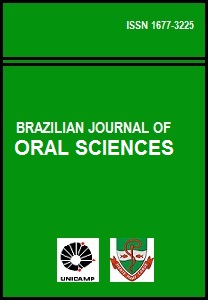Abstract
The aim of this study was to evaluate the influence of polymerization methods (microwave energy - MW, and water bath - WB) and polishing techniques (chemical - C and mechanical - M) on the surface roughness of one heat-polymerized acylic resin (Vipi-Cril). Forty acrylic resin disk-shaped samples were made according to ADA specification nº 12. Half of samples were processed by microwave energy (500W for 3 minutes), and the other half by water bath (74±1 ºC for 9 hours). After deflasking, the samples were trimmed with a sequence of abrasive aluminum oxide sandpapers of different grades (180, 220 and 400) and divided in 4 groups according to polymerization methods and polishing techniques: G1: MW+CP, G2: MW+MP, G3: WB+CP and G4: WB+MP. Surface roughness values were measured using a Surfcorder SE 1700 rugosimeter (Kosaka Laboratory Ltd, Kosaka, Japan). Mann-Whitney test (p=.05) indicated significant differences between polishing methods processed by microwave energy (p= .0018), and between polishing methods processing by water bath (p= .0002). Samples processed by both methods (water bath or microwave energy) showed smoother surfaces when polished by mechanical polishing method, and polymerization methods did not influence in surface roughness.References
Quirynen M, Bollen CM. The influence of surface roughness and surface-free energy on supra and subgingival plaque formation in man, a review of literature. J Clin Periodontol 1995; 22: 1-14.
Verran J, Maryan CJ. Retention of Candida Albicans on acrylic resin and silicon of different surface topography. J Prosthet Dent 1997; 77: 535-9.
Taylor R, Maryan CJ, Veran J. Retention of oral microorganisms on cobalt-chromium alloy and dental acrylic resin with different surface finishes. J Prosthet Dent 1998; 80: 592-7.
Ulusoy M, Ulusoy N, Aydin AK. An evaluation of polishing techniques on surface roughness of acrylic resin. J Prosthet Dent 1986; 56: 107-12.
Quirynen M, Marechal M, Busscher HJ, Weerkamp AH, Darius PL, Van Steenberghe D. The influence of surface-free energy and surface roughness on early plaque formation. An in vivo study in man. J Clin Periodontol 1990; 17: 138-44.
Gotusso MJ. Chemical and superficial treatment of acrylic resin. Rev Asoc Odontol Argent. 1969; 57: 359-61.
Nishii M. Studies on the curing of denture base resins with microwave irradiation with particular reference to heat curing resins. J Osaka Dent Univ. 1968; 2: 23-40.
Mello,JAN, Braun KO, Rached RN, Del Bel Cury AA. Reducing the negative effects of chemical polishing in acrylic resins by use of an additional cycle of polymerization. J Prosthet Dent 2003; 89: 598-602.
Lorton L, Phillips WR. Heat-released stress in acrylic dentures. J Prosthet Dent 1979; 42: 23-6.
Rahal JS, Mesquita MF, Henriques GEP, Nóbilo MAA. Surface roughness of acrylic resins submitted to mechanical and chemical polishing. J Oral Rehabil. 2004; 31: 1075-9.
American Dental Association. Revised American Dental Association Specification nº 12 for dental base polymers. J Am Dent Assoc. 1975; 90: 451-8.
Anusavice KJ. Phillips: dental materials. Rio de Janeiro: Guanabara Koogan; 1998. p.125-39, 394-405.
O’Brien WJ. Dental materials and their selection. Chicago: Quintessence; 1997. p.115-22.
The Brazilian Journal of Oral Sciences uses the Creative Commons license (CC), thus preserving the integrity of the articles in an open access environment.

